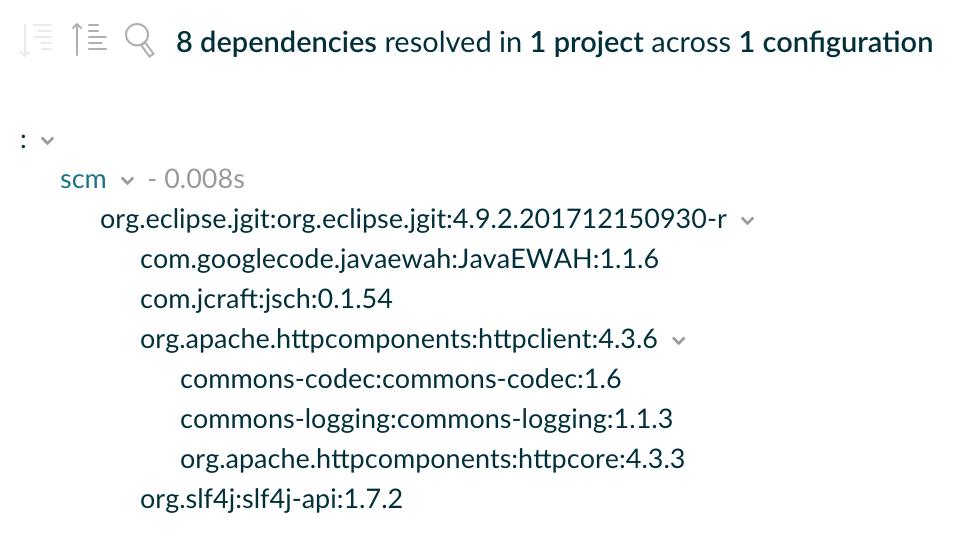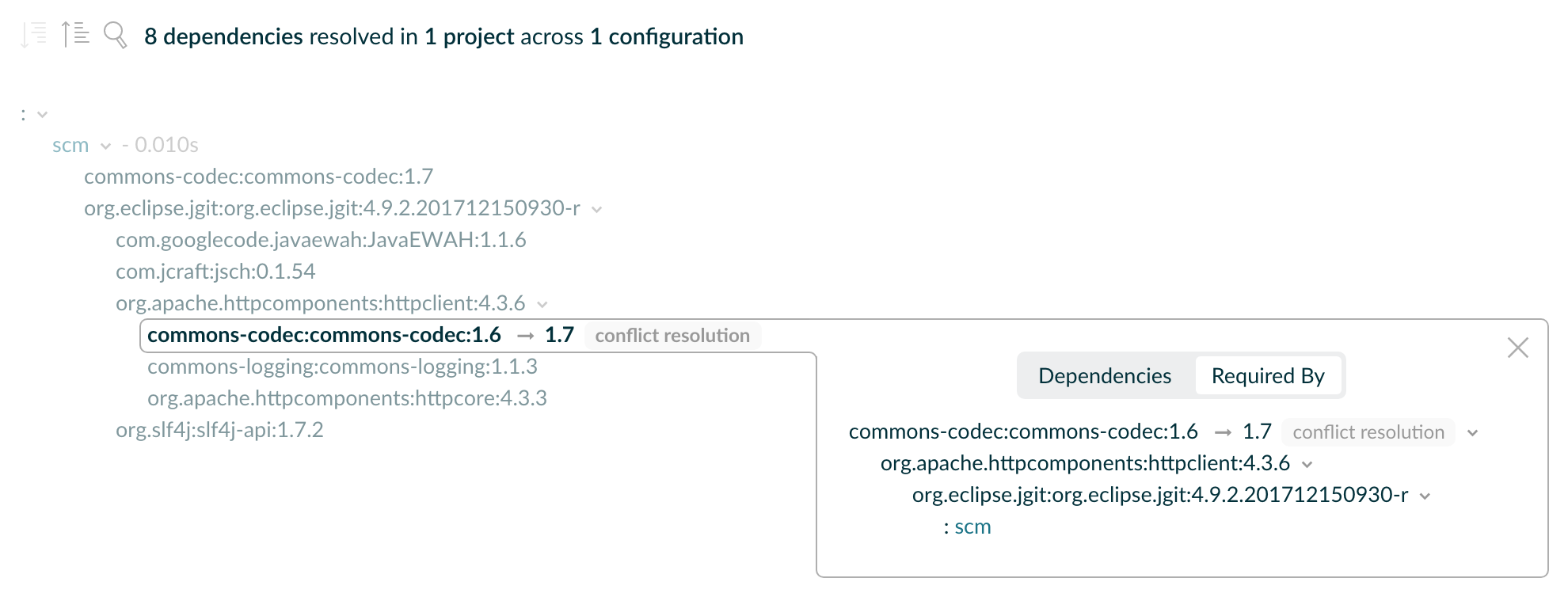Inspecting Dependencies
Gradle provides sufficient tooling to navigate large dependency graphs and mitigate situations that can lead to dependency hell. Users can choose to render the full graph of dependencies as well as identify the selection reason and origin for a dependency. The origin of a dependency can be a declared dependency in the build script or a transitive dependency in graph plus their corresponding configuration. Gradle offers both capabilities through visual representation via build scans and as command line tooling.
Listing dependencies in a project
A project can declare one or more dependencies. Gradle can visualize the whole dependency tree for every configuration available in the project.
Rendering the dependency tree is particularly useful if you’d like to identify which dependencies have been resolved at runtime. It also provides you with information about any dependency conflict resolution that occurred in the process and clearly indicates the selected version. The dependency report always contains declared and transitive dependencies.
Let’s say you’d want to create tasks for your project that use the JGit library to execute SCM operations e.g. to model a release process. You can declare dependencies for any external tooling with the help of a custom configuration so that it doesn’t pollute other contexts like the compilation classpath for your production source code.
GroovyKotlinrepositories {
jcenter()
}
configurations {
scm
}
dependencies {
scm 'org.eclipse.jgit:org.eclipse.jgit:4.9.2.201712150930-r'
}A build scan can visualize dependencies as a navigable, searchable tree. Additional context information can be rendered by clicking on a specific dependency in the graph.

Every Gradle project provides the task dependencies to render the so-called dependency report from the command line. By default the dependency report renders dependencies for all configurations. To pair down on the information provide the optional parameter --configuration.
Example: Rendering the dependency report for a custom configuration
gradle -q dependencies --configuration scm> gradle -q dependencies --configuration scm
------------------------------------------------------------
Root project
------------------------------------------------------------
scm
\--- org.eclipse.jgit:org.eclipse.jgit:4.9.2.201712150930-r
+--- com.jcraft:jsch:0.1.54
+--- com.googlecode.javaewah:JavaEWAH:1.1.6
+--- org.apache.httpcomponents:httpclient:4.3.6
| +--- org.apache.httpcomponents:httpcore:4.3.3
| +--- commons-logging:commons-logging:1.1.3
| \--- commons-codec:commons-codec:1.6
\--- org.slf4j:slf4j-api:1.7.2
A web-based, searchable dependency report is available by adding the --scan option.
The dependencies report provides detailed information about the dependencies available in the graph. Any dependency that could not be resolved is marked with FAILED in red color. Dependencies with the same coordinates that can occur multiple times in the graph are omitted and indicated by an asterisk. Dependencies that had to undergo conflict resolution render the requested and selected version separated by a right arrow character.
Identifying which dependency version was selected and why
Large software projects inevitably deal with an increased number of dependencies either through direct or transitive dependencies. The dependencies report provides you with the raw list of dependencies but does not explain why they have been selected or which dependency is responsible for pulling them into the graph.
Let’s have a look at a concrete example. A project may request two different versions of the same dependency either as direct or transitive dependency. Gradle applies version conflict resolution to ensure that only one version of the dependency exists in the dependency graph. In this example the conflicting dependency is represented by commons-codec:commons-codec.
GroovyKotlinrepositories {
jcenter()
}
configurations {
scm
}
dependencies {
scm 'org.eclipse.jgit:org.eclipse.jgit:4.9.2.201712150930-r'
scm 'commons-codec:commons-codec:1.7'
}The dependency tree in a build scan renders the selection reason (conflict resolution) as well as the origin of a dependency if you click on a dependency and select the "Required By" tab.

Every Gradle project provides the task dependencyInsight to render the so-called dependency insight report from the command line. Given a dependency in the dependency graph you can identify the selection reason and track down the origin of the dependency selection. You can think of the dependency insight report as the inverse representation of the dependency report for a given dependency. When executing the task you have to provide the mandatory parameter --dependency to specify the coordinates of the dependency under inspection. The parameters --configuration and --singlepath are optional but help with filtering the output.
Example: Using the dependency insight report for a given dependency
gradle -q dependencyInsight --dependency commons-codec --configuration scm> gradle -q dependencyInsight --dependency commons-codec --configuration scm
commons-codec:commons-codec:1.7
variant "default" [
org.gradle.status = release (not requested)
]
Selection reasons:
- By conflict resolution : between versions 1.7 and 1.6
commons-codec:commons-codec:1.7
\--- scm
commons-codec:commons-codec:1.6 -> 1.7
\--- org.apache.httpcomponents:httpclient:4.3.6
\--- org.eclipse.jgit:org.eclipse.jgit:4.9.2.201712150930-r
\--- scm
A web-based, searchable dependency report is available by adding the --scan option.
Justifying dependency declarations with custom reasons
When you declare a dependency or a dependency constraint, you can provide a custom reason for the declaration. This makes the dependency declarations in your build script and the dependency insight report easier to interpret.
GroovyKotlinplugins {
id 'java-library'
}
repositories {
jcenter()
}
dependencies {
implementation('org.ow2.asm:asm:6.0') {
because 'we require a JDK 9 compatible bytecode generator'
}
}Example: Using the dependency insight report with custom reasons
gradle -q dependencyInsight --dependency asm> gradle -q dependencyInsight --dependency asm
org.ow2.asm:asm:6.0
variant "compile" [
org.gradle.status = release (not requested)
org.gradle.usage = java-api
org.gradle.category = library (not requested)
Requested attributes not found in the selected variant:
org.gradle.dependency.bundling = external
org.gradle.jvm.version = 11
]
Selection reasons:
- Was requested : we require a JDK 9 compatible bytecode generator
org.ow2.asm:asm:6.0
\--- compileClasspath
A web-based, searchable dependency report is available by adding the --scan option.